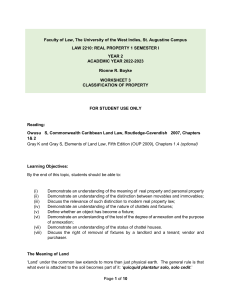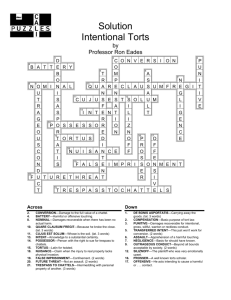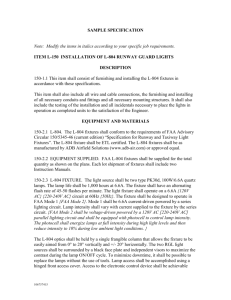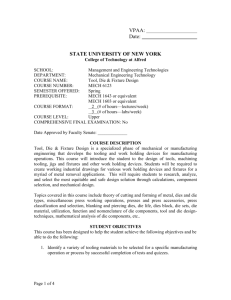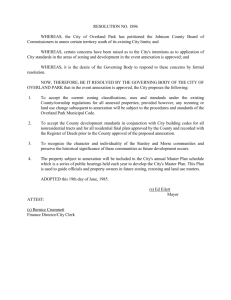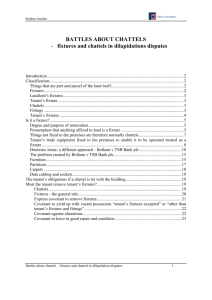Definition of land
advertisement
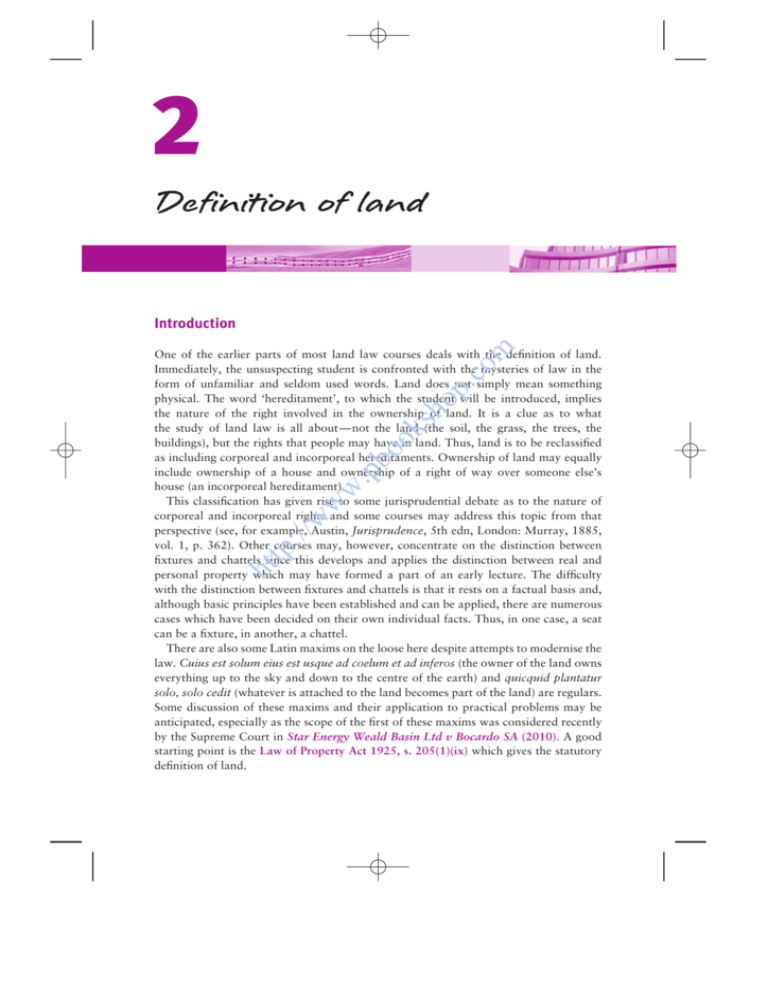
2 Definition of land co m Introduction ht tp : //w w w .p bo ok sh o p. One of the earlier parts of most land law courses deals with the definition of land. Immediately, the unsuspecting student is confronted with the mysteries of law in the form of unfamiliar and seldom used words. Land does not simply mean something physical. The word ‘hereditament’, to which the student will be introduced, implies the nature of the right involved in the ownership of land. It is a clue as to what the study of land law is all about—not the land (the soil, the grass, the trees, the buildings), but the rights that people may have in land. Thus, land is to be reclassified as including corporeal and incorporeal hereditaments. Ownership of land may equally include ownership of a house and ownership of a right of way over someone else’s house (an incorporeal hereditament). This classification has given rise to some jurisprudential debate as to the nature of corporeal and incorporeal rights and some courses may address this topic from that perspective (see, for example, Austin, Jurisprudence, 5th edn, London: Murray, 1885, vol. 1, p. 362). Other courses may, however, concentrate on the distinction between fixtures and chattels since this develops and applies the distinction between real and personal property which may have formed a part of an early lecture. The difficulty with the distinction between fixtures and chattels is that it rests on a factual basis and, although basic principles have been established and can be applied, there are numerous cases which have been decided on their own individual facts. Thus, in one case, a seat can be a fixture, in another, a chattel. There are also some Latin maxims on the loose here despite attempts to modernise the law. Cuius est solum eius est usque ad coelum et ad inferos (the owner of the land owns everything up to the sky and down to the centre of the earth) and quicquid plantatur solo, solo cedit (whatever is attached to the land becomes part of the land) are regulars. Some discussion of these maxims and their application to practical problems may be anticipated, especially as the scope of the first of these maxims was considered recently by the Supreme Court in Star Energy Weald Basin Ltd v Bocardo SA (2010). A good starting point is the Law of Property Act 1925, s. 205(1)(ix) which gives the statutory definition of land. Definition of Land Apart from the Star Energy case, there is little new in this topic; the modern case law is mostly an application of established principles. From this point of view, the topic is a safe one to prepare. Question 1 Cuius est solum, eius est usque ad coelum et ad inferos (the owner of the land owns everything up to the sky and down to the centre of the earth). Discuss. co m Commentary .p bo ok sh o p. This question is either a dream or a nightmare. There is a vast amount of material to be covered and it is unlikely that you can deal with it all. You may be guided by what you have covered in lectures. Treasure trove, for example, has been topical (with the growth in the use of metal detectors) and modern law has now significantly extended the meaning and ambit of ‘treasure’. The usual advice not to regurgitate all you know holds good. Discuss the maxim critically: what are its limitations? Don’t just dismiss it—consider to what extent it holds true. w w Answer plan //w • Limitations on fee simple owner’s rights: tp : – Airspace; – Water; ht – Boundaries—presumptions. • Land—minerals. • Chattels—fixtures or not? Treasure Act 1996. • Wild animals. • Social legislation—planning, housing. Suggested answer This maxim, which was coined by Accursius, a professor at the University of Bologna, in the thirteenth century, relates to the extent of the ownership enjoyed by the fee simple owner. There are, in fact, a number of limitations on the ownership of the fee simple owner. Some are statutory, others are founded in the common law. 5 Definition of Land tp : //w w w .p bo ok sh o p. co m The first aspect to be considered is the extent of the fee simple owner’s rights in the airspace above the property. The owner’s rights extend to such a height as is reasonably necessary for the ordinary use and enjoyment of the land. In Baron Bernstein of Leigh v Skyviews and General Ltd [1978] QB 479, Griffith J stated that it was necessary to balance the rights of an owner to enjoy the land against the rights of the general public to take advantage of all that ‘science now offers in the use of airspace’. Thus, the rights of the owner were limited to such a height as is necessary for the ordinary use and enjoyment of the land and above that height the fee simple owner has no greater rights than any other member of the public. Where there is an interference with the legitimate rights of the fee simple owner then these rights may be maintained by an action for nuisance or trespass. In Kelsen v Imperial Tobacco Co (of Great Britain and Ireland) Ltd [1957] 2 QB 334, the action of the defendant in allowing an advertisement to overhang the plaintiff’s premises amounted to a trespass as was the action of the defendant in Woollerton and Wilson Ltd v Richard Costain Ltd [1970] 1 WLR 411, in allowing the jib of a crane to swing over the plaintiff’s property. Under the Civil Aviation Act 1982, it is a defence to an action in trespass or nuisance for aircraft to fly at such a height which is reasonable under the circumstances. The rights of the fee simple owner in water on the land are, in part, derived from statute. The right to abstract water is controlled by the Water Resources Act 1991 and depends on the grant of a licence from the Environment Agency. Where water flows in a defined channel across the land, then there is a distinction between water which is tidal and that which is non-tidal. The water itself is not capable of ownership, but there are rights in the bed and the right to take the fish to be considered. Where the water is tidal, the bed belongs to the Crown and the public have a right of navigation and a right to fish up to the point where the water ceases to be subject to the ebb and flow of tides. In many rivers this point is determined by the presence of a lock-gate. Where the water is non-tidal, then the bed belongs to the riparian owner. If the water forms the boundary between two plots of land, then subject to any contrary agreement or evidence, the riparian owners own up to the midway point in the river or stream. They are also entitled to take the fish, a valuable property right on many country estates. A riparian owner does not own the water itself, but may use it for ordinary purposes connected with the riparian tenement, regardless of the amount he uses. If he uses it for any extraordinary purpose, such as manufacturing, then he must restore it in approximately the same quantity and quality. Water percolating underneath the land and not contained in a defined channel, is not capable of ownership until such moment as it is appropriated, when it becomes the property of the person appropriating it (Ballard v Tomlinson (1885) 29 ChD 115). Where water, such as lakes and ponds, lies on the land, it is the property of the landowner, subject to the Water Resources Act 1991. ht 6 Definition of Land ht tp : //w w w .p bo ok sh o p. co m If the land verges on the seashore, the fee simple owner owns that part of the land down to a point reached by an ordinary high tide. Where the land is bordered by a hedge and ditch the rebuttable presumption is that the boundary lies at the furthest edge of the ditch (Vowles v Miller (1810) 3 Taunt 137; Alan Wibberley Building Ltd v Insley [1999] 2 All ER 897). The maxim also states that the landowner owns everything down to the centre of the earth. While it is true that at common law all minerals are owned by the landowner, ownership is in fact vested by various statutes in the Crown or other public bodies. For example, petroleum in its natural state is vested in the Crown by virtue of the Petroleum Act 1998 and coal is vested in the Coal Authority by the Coal Industry Act 1994. In Star Energy Weald Basin Ltd v Bocardo SA [2010] UKSC 35, Star Energy, which had a licence under statute to search for and extract petroleum, had drilled wells that went directly under Bocardo’s land at a minimum depth of 800 feet, and which reached depths of up to 2,900 feet in order to reach the natural reservoir of petroleum and gas. The drilling under Bocardo’s land was done without its consent, and (for many years) without its knowledge. Bocardo claimed damages for trespass from Star Energy; in order to succeed it needed to show that it had title to the subterranean land at the depths at which the drilling took place. Lord Hope (with whose judgment the other members of the Supreme Court agreed) concluded that, in relation to what lies below the surface, the maxim is still good law. He admitted that at great depths, where there is enormous pressure and molten rock, it is impractical to seek to apply the maxim; but that was not the case here. Although the drilling was at such depths that it did not interfere with Bocardo’s own use of its land, the fact that the petroleum could be reached by human activity raised the question of who owned the strata in which it was found. Although the Crown owned the petroleum, it did not own the surrounding strata; the only possible owner was therefore Bocardo, and the drilling was held to be an actionable trespass and Bocardo was awarded damages. No injunction was claimed in the case, and it seems unlikely that an injunction would be awarded in these sorts of circumstances, where the trespass is technical and does not cause the claimant any loss or inconvenience. The fee simple owner is prima facie entitled to all chattels found in or on the land, in the absence of a legitimate claim from the owner of the chattel, unless (where the object is found on the land) the finder acquires a prior right. Treasure (as defined in the Treasure Act 1996) is an exception to this: it vests in the Crown, subject to prior rights and interests. Wild animals are not subject to ownership (The Case of Swans (1592) 7 Co Rep 156), but may be hunted by the fee simple owner on whose land they run. There are, however, a number of limitations to this right in respect of protected species (Wildlife and Countryside Act 1981 (as amended) and the Protection of Badgers Act 1992, for example). 7 Definition of Land tp : //w w w .p bo ok sh o p. co m Land is defined in the Law of Property Act 1925, s. 205(1)(ix) as including ‘the surface, buildings or parts of buildings’ and whatever is attached to the land becomes part of the land under another Latin maxim, quicquid plantatur solo, solo cedit. This raises, in practice, an important problem relating to ownership of those items which, but for the fact that they are attached to the land, would constitute chattels. The distinction needs to be drawn between those items which are fixtures, and therefore part of the realty, and those which are not, and therefore remain personalty. There are two tests for determining whether an object is a fixture or a chattel. The first test relates to the degree of annexation. If the object is annexed to the land then it is, prima facie, a fixture. So, in Holland v Hodgson (1872) LR 7 CP 328, spinning looms bolted to the floor of a factory were attached other than by their own weight and were fixtures. In Hulme v Brigham [1943] KB 152, however, heavy printing presses which stood on the floor without any attachment other than the force of gravity, were chattels. In Chelsea Yacht & Boat Co v Pope [2000] 1 WLR 1941, a houseboat which was moored to the bank and which moved up and down with the tide, was held to be a chattel. The paramount test, however, was foreshadowed by Blackburn J in Holland v Hodgson and relates to the purpose of annexation. Under this test, the question to be asked is whether the chattel has been affixed to the land for the better enjoyment of the object as a chattel, or for the more convenient use of the land. This leads to the result that the same object may constitute a fixture in one case, but a chattel in another. For example, in Leigh v Taylor [1902] AC 157, tapestries nailed to a wall were held not to be fixtures, but in Re Whaley [1908] 1 Ch 615, similar objects were held to be fixtures because the object of their annexation was to enhance the room. Lord Halsbury LC in Leigh v Taylor confirmed that the key test was the purpose of annexation, and this was confirmed in Hamp v Bygrave (1982) 266 EG 720 where garden ornaments that formed part of a landscape display were held to be fixtures despite the fact they rested on the ground simply by their own weight. In Elitestone Ltd v Morris [1997] 1 WLR 687, the House of Lords held that what is of primary importance is the intention involved. It was indicated that this is an objective test to determine whether the object was intended for the use or enjoyment of the land, or for the more convenient use of the object itself. Clearly, the courts are prepared to apply a common-sense approach to this issue (Botham v TSB Bank plc (1997) 73 P & CR D1). There are some exceptional cases where there is a right to remove fixtures. A tenant may remove trade fixtures that have been attached to the land for the purpose of carrying out his trade; ornamental and domestic fixtures provided their removal will cause no substantial damage to the property; agricultural fixtures in accordance with the procedure set out in the Agricultural Holdings Act 1986. There are also a number of limitations on the right of the fee simple owner to enjoy the land in the form of the Town and Country Planning Act 1991 and related legislation, which controls developments on land, and the Housing Acts and Rent Acts, which control the standard for houses for human habitation and the security of tenure of certain tenants. ht 8 Definition of Land Question 2 Abel has entered into a contract to sell his house to Baal. He consults you as to whether the following items (which were not mentioned in the contract of sale) are to be included in the sale: (a) a replica of the ‘Three Graces’ which is standing in the garden; (b) a stained glass lampshade, attached to the ceiling by a chain, which was given to him by friends when he got married; (c) the fitted kitchen which Abel installed himself (he wants to dismantle it and adapt it for his new house); (d) adjustable bookshelves which slot into strips of metal screwed into the wall; and co m (e) an ornamental fireplace which is on hire-purchase from Quickfire Ltd. sh o p. Commentary ht tp : //w w w .p bo ok Unusual in a land law examination, this question concentrates on one aspect of a subject—that of the distinction between fixtures and chattels. There is an abundance of well-known case law in this area and the principles are well established. The judgment of Scarman LJ in Berkley v Poulet (1976) 242 EG 39 lays out the principles clearly and concisely, and the area was considered by the House of Lords in Elitestone Ltd v Morris [1997] 1 WLR 687. For the effect of hire-purchase agreements see Guest and Lever (1963) Conv (NS) 30; McCormack [1990] Conv 275. Many of the cases vary according to their facts so it is important to distinguish principles of law in this area from issues of fact. Land and chattels are treated differently at law; freehold land is real property and chattels are personal property. A contract to sell land will not include chattels unless they are expressly included. Sometimes an item that was once a chattel may become part of the land and there are, on occasions, difficulties in naming the distinction between fixtures (which form part of the land) and chattels (which remain items of personal property). Under the Law of Property Act 1925, s. 62, fixtures are included in a conveyance of land. This question deals with this fundamental distinction. Answer plan • Purpose of distinguishing between fixtures and chattels. • Tests to distinguish between fixtures and chattels. • Discussion of development of tests through case law. • Initial test—degree of annexation. • Discussion of case law in relation to each scenario in (a), (b), (c), (d), and (e). 9 Definition of Land Suggested answer (a) There are two tests to determine whether an item has become part of the freehold: (i) the method and degree of annexation; (ii) the object and purpose of the annexation. tp : //w w w .p bo ok sh o p. co m The earlier law emphasised the first test, while later cases introduced the second test to alleviate the injustice where limited owners had affixed items of value to the land. The second test is now dominant, so if the item is physically annexed to the land this does not necessarily resolve the matter any more. Nevertheless the degree of annexation remains a relevant question. According to Scarman LJ in Berkley v Poulet (1976) 242 EG 39, if there is such a degree of physical annexation that an object cannot be removed without serious damage to, or some destruction of, the realty, then there is a strong case for the item to be classified as a fixture. In Chelsea Yacht & Boat Co v Pope [2000] 1 WLR 1941, a houseboat which was moored by ropes, chain, and an anchor was held to be a chattel. Thus, the determination of the question whether the ‘Three Graces’ is a fixture will depend on an application of the two tests. It is not clear whether the statue is physically fixed to the land, although it would seem from the question that it is merely ‘standing’ on the land. If that is the case, then, prima facie, the statue is not a fixture. In the case of Berkley v Poulet itself, a white marble statue of a Greek athlete weighing half a ton and standing on a plinth, was considered not to be a fixture. Similarly, a printing machine secured by its own weight and weighing several tons was held not to be a fixture (Hulme v Brigham [1943] KB 152). However, the general rule can be displaced where the object of annexation is that the chattels should become part of the land. Thus, a drystone wall which was constructed of blocks of stone placed one on top of another was held to have been intended to become part of the realty (Holland v Hodgson (1872) LR 7 CP 328). Intention refers to the purpose which the object serves, not to the purpose of the person who put the object in place: Elitestone Ltd v Morris [1997] 1 WLR 687 (HL). The fact that the ‘Three Graces’ is an ornamental object may not be a conclusive indication that it is not intended to become part of the land. In Lord Chesterfield’s Settled Estates [1911] 1 Ch 237, Grinling Gibbons carvings were held to be fixtures; and in Re Whaley [1908] 1 Ch 615, chattels, which were placed in the room in order to create a beautiful room as a whole, were held to be capable of being fixtures. In D’Eyncourt v Gregory (1866) LR 3 Eq 382, statues which were part of the architectural design of a property were held to be fixtures. However, in this problem, regardless of the question whether the ‘Three Graces’ are in fact physically affixed to the ground, it would seem probable that the statue remains a chattel unless, as in Hamp v Bygrave (1982) 266 EG 720, it can be objectively viewed as a feature of, and part and parcel of, the garden, or, as in D’Eyncourt v Gregory, as a part of the architectural design of the house. ht 10 Definition of Land ht tp : //w w w .p bo ok sh o p. co m (b) The stained glass lampshade would not seem to pose the same difficulties. It is an object that is essentially a chattel and it is unlikely that any evidence could be adduced to change its character into a fixture. If the first test were to be applied alone, then there is a degree of physical annexation which might suggest that the lampshade was a fixture. This test is no longer decisive. In Leigh v Taylor [1902] AC 157, tapestries were fixed to the wall. The House of Lords held that the purpose of their annexation to the realty was for their better enjoyment as tapestries. Annexation on its own was not enough to make them fixtures. This decision was followed in the case of Spyer v Phillipson [1931] 2 Ch 183, where oak and pine panelling and a chimney-piece had been erected, and, in Berkley v Poulet (1976) 242 EG 39, in relation to pictures which were hung in recesses in a panelled room. Thus, it is likely that the lampshade will be a chattel. (c) The fitted kitchen poses a different problem. In the first place it is clearly annexed so it raises the general rule that it constitutes a fixture. Secondly, it would seem to be unarguable that the object of its annexation was for any other purpose than to create a room which could be used as a kitchen. While the fitted furniture may have been aesthetically pleasing, its primary purpose was for use as a kitchen. In Re Whaley [1908] 1 Ch 615 the design of a beautiful room, ‘an Elizabethan Room’, by the installation of chattels of beauty, meant that those chattels became part of the room—they were fixtures. The unity of design of the room meant that the objects were part of the realty. The result in Lord Chesterfield’s Settled Estates (above) was similar. In Botham v TSB Bank plc (1997) 73 P & CR D1 the Court of Appeal decided that bathroom and kitchen units were fixtures whereas kitchen white goods, such as refrigerators, were still chattels. (d) Similar arguments might prevail in respect of the bookshelves. They are annexed although they could be easily removed with little damage. The object of their annexation is to make the room useful as a library (Re Whaley). In fact, there would seem to be no question as to their intrinsic merit as chattels. The bookshelves have been installed for the more convenient use of the property, not for their use as chattels. In Vaudeville Electric Cinema Ltd v Muriset [1923] 2 Ch 74, seats secured to the floor of a cinema hall were fixtures. Normally, free-standing seats would be considered chattels. Here, however, they were affixed to make the hall more convenient as a cinema and were held to be fixtures. On these grounds, therefore, it is arguable that the shelves become fixtures. (e) Here the fireplace is annexed to the room. It is described as ornamental and might, therefore, fall into the category of the tapestries in Leigh v Taylor which, although affixed, were deemed to be chattels because the object of their annexation was for their better enjoyment as such. However, there is a further complication in that the fireplace is being purchased as part of a hire-purchase scheme. If the fireplace has been annexed to the land of the hirer, then it becomes annexed to the realty and the original owner (Quickfire Ltd) loses its title. It will be necessary to consider the contract of hire-purchase to see whether 11 Definition of Land Quickfire Ltd has reserved to itself the right to remove the fireplace in the event of default in the payment of the hire-purchase instalments. If there is such a right of removal, then this confers on Quickfire Ltd an equitable interest in the land which is a right of entry (Re Morrison, Jones & Taylor [1914] 1 Ch 50). Whether this right of entry is binding on Baal will depend on whether the land is registered or unregistered. If unregistered, then the equitable doctrine of notice prevails and Baal will be bound unless he is a bona fide purchaser of a legal estate for value without notice (Poster v Slough Estates Ltd [1969] 1 Ch 495). If the land is registered, then strangely enough, the right of entry will not bind a purchaser since it is not an overriding interest and may not be registrable as a minor interest. Further reading co m Austin, J., Jurisprudence, 5th edn, Murray, 1885, vol. 1, p. 362. tp : //w w w .p bo ok McCormack, G. [1990] Conv 275. sh o Guest, A., and Lever, J. (1963) Conv (NS) 30. p. Burn, E. H., and Cartwright, J., Cheshire and Burn’s Modern Law of Real Property, 17th edn, Oxford, 2006. ht 12

